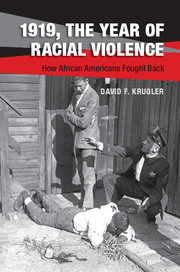Book contents
- Frontmatter
- Dedication
- Contents
- Acknowledgments
- Source Abbreviations and Usage Note
- Introduction
- 1 World War I and the New Negro Movement
- 2 “We Return Fighting”
- 3 Fighting a Mob in Uniform
- 4 Blood in the Streets
- 5 Armed Resistance to the Courthouse Mobs
- 6 Armed Resistance to Economic Exploitation in Arkansas, Indiana, and Louisiana
- 7 “It Is My Only Protection”
- 8 The Fight for Justice
- 9 The Fight for Justice
- 10 Fighting Judge Lynch
- Conclusion
- Bibliography
- Index
- References
8 - The Fight for Justice
The Arrests and Trials of Black and White Rioters
Published online by Cambridge University Press: 05 December 2014
- Frontmatter
- Dedication
- Contents
- Acknowledgments
- Source Abbreviations and Usage Note
- Introduction
- 1 World War I and the New Negro Movement
- 2 “We Return Fighting”
- 3 Fighting a Mob in Uniform
- 4 Blood in the Streets
- 5 Armed Resistance to the Courthouse Mobs
- 6 Armed Resistance to Economic Exploitation in Arkansas, Indiana, and Louisiana
- 7 “It Is My Only Protection”
- 8 The Fight for Justice
- 9 The Fight for Justice
- 10 Fighting Judge Lynch
- Conclusion
- Bibliography
- Index
- References
Summary
Throughout 1919, African Americans recognized that resistance to antiblack collective violence required sustained legal action to achieve three related goals: first, to ensure that blacks arrested for riot-related crimes received unbiased adjudication of the charges against them; second, to pressure authorities to charge and try white rioters; and third, to win financial compensation for the victims of mob assaults. This chapter focuses on this threefold fight for justice in the aftermath of the riots in Charleston, Longview, Washington, Chicago, Knoxville, and Omaha, all of which occurred between May and September 1919.
African Americans’ legal initiatives in these communities shared several features. The national office and branches of the NAACP hired lawyers and raised defense funds for scores of black defendants. Black lawyers offered their services to jailed men and women. Black leaders in Charleston, Washington, and Chicago expanded their post-riot legal defense efforts into campaigns to end problems such as police and military mistreatment of African Americans. The collection of affidavits from victims of mob violence yielded substantial evidence of crimes against blacks and helped pressure authorities to file charges against white rioters. In Knoxville and Omaha, white authorities needed no prodding – they were eager to prosecute white rioters because of the extensive damage they had caused to the courthouses in both cities. Convictions proved elusive, however, as all-white juries acquitted almost every defendant. Supportive of the rioters’ rough justice motives, jurors appeared willing to excuse crimes committed in the act of lynching (or of trying to lynch) black men. Similar difficulties in obtaining convictions attended the legal proceedings in Charleston and Longview.
- Type
- Chapter
- Information
- 1919, The Year of Racial ViolenceHow African Americans Fought Back, pp. 213 - 244Publisher: Cambridge University PressPrint publication year: 2014



